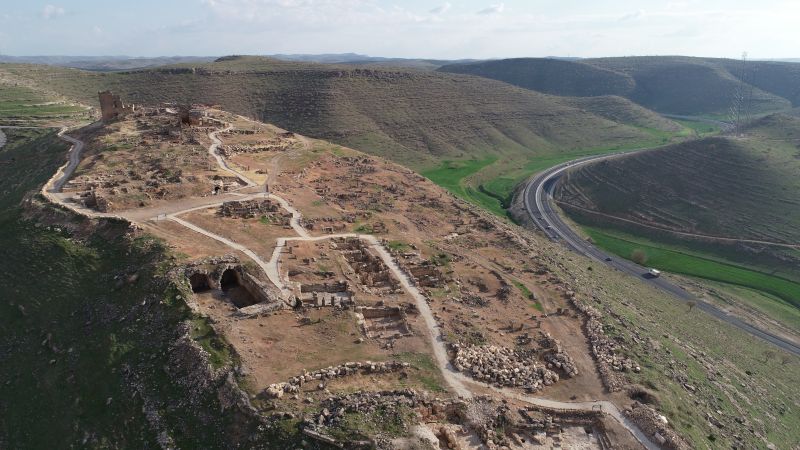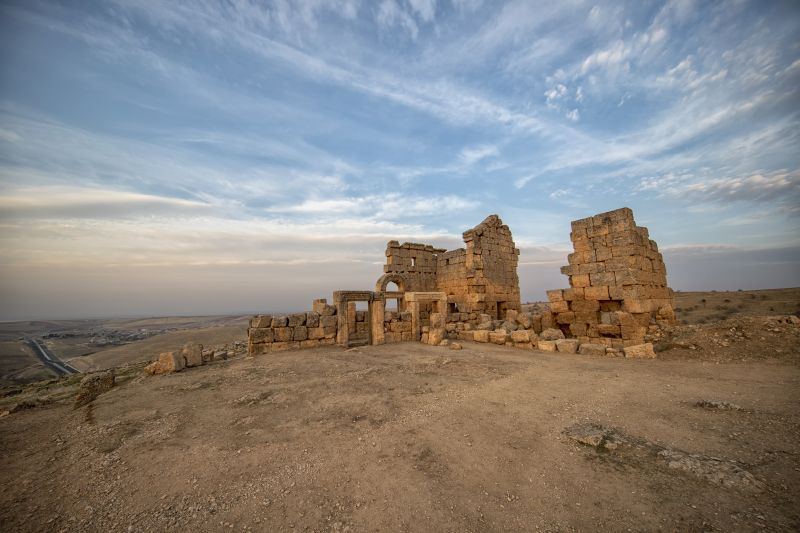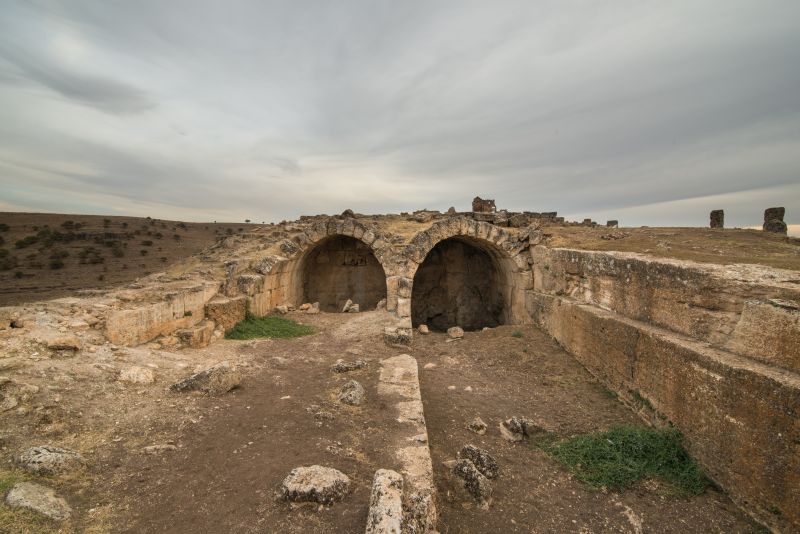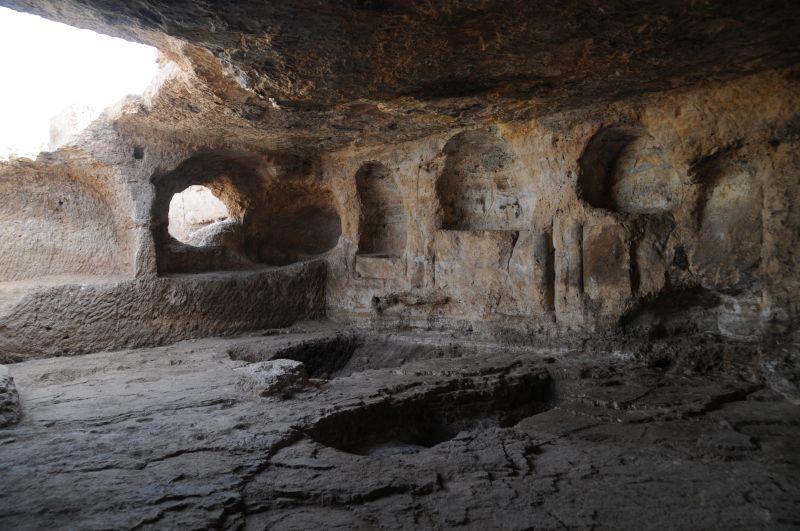Doç.Dr. Aytaç COŞKUN ve Ekibinin Araştırması
ZERZEVAN KALESİ - ROMA’NIN SINIR
GARNİZONU
Zerzevan Kalesi Diyarbakır ili, Çınar
ilçesi, Diyarbakır-Mardin karayolu üzerinde yer almaktadır. Roma’nın sınır
garnizonu olan Zerzevan Kalesi’nin tarihi 3 bin yıl öncesine, Asur Dönemi’ne
(MÖ 882-611) kadar gitmektedir. Pers Dönemi’nde de (MÖ 550-331) Kral Yolu
üzerinde bulunan yerleşim alanı yol güvenliğinin sağlanması amacıyla
kullanılmıştır. Roma Dönemi’nde MS 3. yüzyılda Severuslar Dönemi’nde (MS
198-235) asıl askeri yerleşim inşa edilmiştir. Yerleşimin surları ve yapıları Anastasios I (MS 491-518) ve Justinianos I (MS 527-565) dönemlerinde
onarılarak, bazı yapılar ise yeniden inşa edilerek mevcut son haline
getirilmiştir. 639 yılında İslam ordularının fethine kadar da kesintisiz
kullanılmıştır. Dünyanın en iyi korunmuş askeri yerleşimde dünyada bulunmuş son
Mithras Tapınağı bulunmaktadır. Bu yapı Roma’nın doğu sınırındaki ilk
tapınaktır.
1200 metre uzunluğunda, 15 metre
yüksekliğinde surlarla çevrelenmiş askeri yerleşimde, güney alanda, gözetleme ve
savunma kulesi, kilise, yönetim binası, arsenal, kaya sunağı gibi mimari
yapılar yer almaktadır. Kuzeyinde ise cadde-sokaklar, villalar ve konutlar
takip edilebilmektedir. Konutların bulunduğu alanda ayrıca su sarnıçları,
yeraltı kilisesi, yeraltı sığınağı ve Mithras Tapınağı yer almaktadır. Surların
dışında ise yerleşime su sağlayan kanallar, sunu çanakları ve taş ocakları
görülebilmektedir. Nekropol alanında ise kaya mezarları ve tonozlu mezarlar
dikkati çekmektedir. Zerzevan Kalesi’nde hem yer üstü, hem de büyük bir yer
altı şehri bulunmaktadır. Zerzevan Kalesi ve Mithras Tapınağı UNESCO Dünya
Mirası geçici listesinde yer almaktadır.
Zerzevan Kalesi kazı ve restorasyon
çalışmaları, Kültür ve Turizm Bakanlığı ile Dicle Üniversitesi işbirliğiyle, Doç.Dr.
Aytaç COŞKUN'un başkanlığında 2014 yılında başlatılmıştır ve halen devam
etmektedir.
MITHRAEUM
Zerzevan Kalesi’nin kuzeyinde yer
alan Mithraeum yeraltına ana kaya oyularak inşa edilmiştir. Yapının doğu
duvarında ana kayaya oyulmuş sütunlar ve ortada büyük, yanlarda iki küçük niş
bulunmaktadır. Ortadaki büyük niş etrafındaki iki sütunun üzerinden yükselen
kuşak üzerinde boya kalıntıları izlenebilmektedir. Muhtemelen söz konusu
kuşakta Mithras’a ait semboller bulunmaktaydı. Mithras’ın boğayı kurban ettiği sahnenin
yer aldığı plaka da yine bu ortadaki büyük nişe konulmaktaydı. Doğu duvara
Mithras’ın sembollerinden olan ışın tacı motifi de kazınmıştır. Küçük nişlerden
birisinde oldukça düzgün oyulmuş su veya kan çanağı ve hemen önünde zeminde
havuz bulunmaktadır. Su veya kan çanağı ile havuz duvarın içinden geçen bir
kanal ile bağlantılıdır ve Mithras dini törenlerinde su veya kan kullanıldığı
bilinmektedir. Ayrıca tavan kısmında simetrik olarak yapılmış dört adet hayvan
bağlama yeri de bulunmaktadır. Bağlama yerleri Mithras ayinlerinde kurban
törenleri için kullanılmış olmalıdır. Yapı, Roma İmparatorluğu’nun doğu
sınırında tespit edilen ilk ve tek Mithras tapınağıdır. Yapının giriş kapısında
ise yazıt ve semboller açık bir şekilde görülmektedir.
Pers kökenli olan tanrı Mithras
“anlaşma ve dostluk” kavramlarının tanrısıdır, “aracılık eden” anlamına gelir.
Mithras güneş tanrısıdır ve kültü güneş tapınımına dayanır. Ayrıca ışığın,
savaşın, adaletin ve inancın da simgesidir. MS 2. ve 3. yüzyılda Roma
İmparatorluğunda oldukça yaygınlaşmıştır. MS 4. yüzyılda Hıristiyanlığın
yayılmasıyla birlikte ise yasaklanmıştır. Gizem dini Mithraizm Romanın egemen
olduğu bütün topraklarda özellikle askerler, tüccarlar ve aristokratlar
arasında oldukça yaygındır. Öğretisi dünyanın yaratılışı üzerinedir ve evreni
kontrol eden tanrı olarak da bilinir. Dinsel törenleri gizlidir ve dışarıya
tamamen kapalıdır. Mithras dinine katılacak kişi on iki eziyeti çekmek
zorundadır. Sadece erkeklerin kabul edildiği bu dine katılanlar yedi aşamadan
geçmektedirler. Törenler yeraltında mağaralarda veya tapınaklarda
gerçekleştirilmektedir.
ZERZEVAN CASTLE - ROMAN BORDER
GARRISON
Zerzevan Castle is
in Diyarbakır province, Çınar district, on the Diyarbakır-Mardin highway. The
history of Zerzevan Castle, which is the border garrison of Rome, dates back 3
thousand years to the Assyrian Period (882-611 BC). It is also likely that
residential area located on the King's Road during the Persian period (550-331
BC) has been
used with an eye to provide road safety. At Roman Period, in the 3rd
century AD the main military settlement was built during the Severus Period (198-235 AD). It can be said that the city
walls and buildings of the settlement were restored in the periods of
Anastasios I (491-518 AD) and Justinian I (527-565 AD), and some of the
constructions were reconstructed and thus the present final state was
obtained. The settlement was used until 639 which is the conquest year of
the region by the Islamic armies. In this best preserved military settlement,
there is the last Mithras Temple found in the world. The structure is the first and only Mithras temple to
be found on the eastern border of the Roman Empire.
In the southern area of the military
settlement surrounded by walls of 1200 meters in length and 15 meters in
height, there are architectural
remains such as observation and defensive towers, church, administrative
building, arsenal and rock altar. In the north, street-alleys and houses can be
observed. Water cisterns, underground church, underground
shelter, Mithras Temple have also been identified in the area where residences
are located. There are canals providing water to the settlement, ceremony
basins and stone quarry outside the city walls in addition to the rock tombs
and vaulted tombs in the necropolis area. Zerzevan Castle has both an
aboveground and a large underground city. Zerzevan Castle and Mithras Temple
was inscribed on the UNESCO World Heritage tentative list.
The excavation and restoration
studies at Zerzevan Castle, which began in 2014, are still being carried out
with cooperation of Ministry of Culture and Tourism and Dicle University, under
the chairmanship of Doç. Dr. Aytaç COŞKUN.
MITHRAEUM
Mithraeum was
carved into the main rock, nearly in the north of the Zerzevan Castle. On the
eastern wall of the structure, there are
columns carved into the main rock , two large
niches in the middle and two small niches on both sides. Paint residues
can be seen on the belt rising above the two columns around the big niche in
the middle. Probably on the aforesaid belt there were symbols belonging to
Mithras religion. The plaque on which Mithras’ sacrificing the bull scene was
carved, was also placed in the big niche in the middle. The crown beam motif as one of the symbols of Mithras is
carved on the eastern wall. In one of the small niches there is a rather
smoothly carved water or blood bowl and a pool on the ground right in front of
it. The water or blood bowl and the pool are connected to each other with a
channel through the wall and it is known that water or blood was used in the
Mithras religious ceremonies. In addition there are four symmetrical points on
the ceiling for hanging the animals during the ceremonies. The hanging points
must have been used to sacrificial rite in Mithras rituals. The structure is
the first and only Mithras temple to be found on the eastern border of the
Roman Empire. At the entrance gate of the structure, the inscriptions and
symbols are clearly visible.
The god Mithras,
of Persian origin, is the god of concepts of
“agreement and friendship”, which means “mediating”. Mithras is the god
of the sun and the cult is based on worshipping the sun. It is alo the symbol
of light, war, justice and faith. In the 2 nd
and 3 rd centuries AD, it became rather common in the Roman Empire. In
the 4th century AD, it was banned with the spread of Christianity. The
Mithraism mystery religion was quite common especially among the soldiers, merchants and aristocrats in all the lands where the Roman rule was dominant.
Its teaching is about the creation of the world and is also known as the god
who controls the universe. The religious ceremonies were secret and closed to
the outside. The person to participate in Mithras religion had to draw twelve
persecutions. The members of this religion to which only men are accepted had
to go through seven stages. The ceremonies were held underground in caves or
temples.
|

|
|
1- Roma’nın Sınır Garnizonu olan Zerzevan
Kalesi Diyarbakır ili, Çınar ilçesi’nde, Diyarbakır-Mardin karayolu üzerinde
yer almaktadır. / Zerzevan Castle, which is the border garrison of Rome is in Diyarbakır
province, Çınar district, on the Diyarbakır-Mardin highway
|
|

|
|
2- Yerleşimin yüksek olan güney bölümünde kamu yapıları bulunmaktadır. Kentte en iyi korunmuş kamu yapılardan birisi doğu-batı doğrultusunda 4 mekândan oluşan Büyük Kilise’dir. / There are public buildings located in the southern part of the settlement which is the higher part of the settlement. One of the most well-preserved public buildings in the city is the Grand Church with four spaces in the east-west direction.
|
|

|
|
3- Savunma amaçlı inşa edilen askeri yerleşim 1200 metre uzunluğunda, 15 m. yüksekliğinde surlar ile çevrelenmiştir. / The military settlement built for defense has been surrounded by 1200 meters long, 15 m. high city walls.
|
|
|
|

|
|
4- Yerleşimde su ihtiyacını karşılayan ana kayaya oyulmuş 63 sarnıç yapısı tespit edilmiştir. / There are 63 cisterns carved into the bedrock fulfilling the water requirements of the settlement.
|
|
 5- Zerzevan Kalesi’nin kuzeyinde yer alan Mithras Tapınağı yeraltına ana kaya oyularak inşa edilmiştir. Yapı dünyadaki en iyi korunmuş Mithras tapınaklarından birisidir. / Mithras Temple was carved into the main rock, nearly in the north of the Zerzevan Castle. It is also one of the best preserved Mithras temples in the world.
|